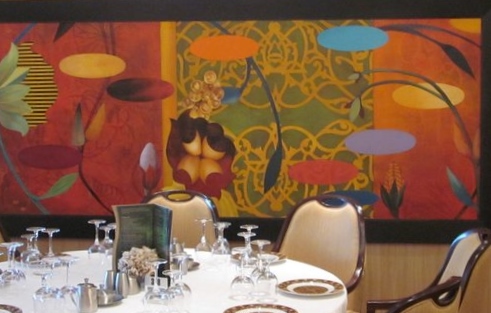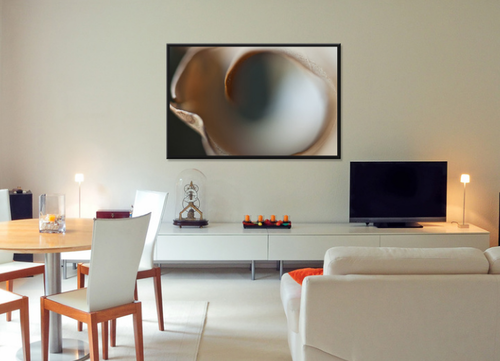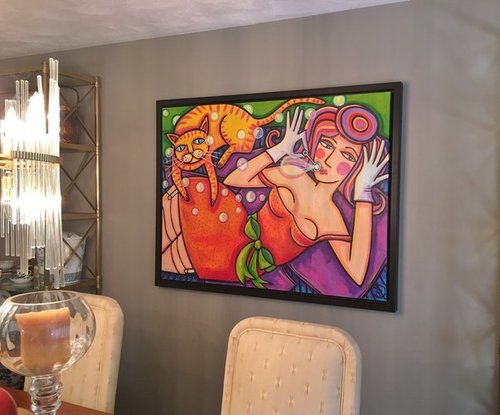by Carolyn Edlund
Have you ever sold your artwork to interior designers? Or wanted to? These design experts share insights on how to get started in this market.

Artist Barbara Rogers’ work is prominently featured in a cruise ship setting.
Interior designers may work on residential or commercial projects. They may be paid hourly by their clients, or may mark up the cost of furnishings, accessories, and other items in order to earn their fee. Either way, they must source all types of products, from floor coverings to lighting to artwork in order to create spaces that work for their clientele.
Since designers are acting on behalf of their customers, they search for particular pieces that are a fit for the project. That means that although they may love an artist’s work, if it isn’t right for the room, they won’t buy. Artists can build long-term business relationships with designers, but should understand these priorities.
What do you need to know to begin working with interior designers?
Joyce Creiger, the founder of Art Specifier, an online art resource for designers, shares some basics.
“One of the most important things an artist needs to think about if they want to work with designers is to be flexible,” she says. “Many designers have a pre-conceived idea of what they want the art to look like for their projects. It might require an artist to be willing to change colors, size, the substrate or process. And in many cases, even the cost. If they want the designer to consider working with them on an ongoing basis, all of these issues are up for discussion.”
A willingness to work as part of a team is essential, as well as setting your ego aside. If you dislike compromise, this type of work might not be a good fit. Creiger notes “There is a big difference between an artist preparing for an exhibition of their work vs. trying to be included in a hotel, hospital or other commercial project with a designer at the helm.”
All may not be lost, however, if you feel that you need to stay true to your muse and create what inspires you rather than tailor your work to the project. She adds, “If making radical changes is not something that is part of the artist’s lexicon, then they need to look for the right designers. These are people who are really looking to incorporate art in their projects without trying to improve it. They appreciate the original vision of the artist and are willing to display the work as originally intended.”

This interior features work by photographer Jennifer S. Beavers.
Finding these designers is more difficult and requires in depth research. Creiger suggests that the artist go to the library, check out interior magazines, see which ones incorporate original artwork, and contact those designers. She adds, “Look at the work and get familiar with artists that were selected. You can see if works were designed for the space or came out of the artist’s studio in ‘as is’ condition.”
What do individual designers feel about working with artists on their projects?
We asked Denver designer Meg Miller (who is also an artist) where she locates art for her interior projects.
“I never go to galleries, because it adds to the expense and doesn’t allow for direct interaction with the artist,” she says. “I like to support local talent. This means that if I like what I see on Instagram or Facebook, I can research and contact those people for further discussion. And meet with them and my client if we’re doing a commission.”
She has found that if original artwork isn’t in the budget, she can discuss options with the artist. They may be willing to reproduce their work in various sizes and/or on various materials (wood, plexiglass, metal, etc.) to give it a fresh new look.
As a designer, she has found that “It’s important to develop a network on social media with your local community of artists, artisans, fabricators, art resource printers, etc. That expands the possibilities for how art can be incorporated into a project. Be the facilitator and think outside the box of possibilities of what can be done. I write down what was discussed and clarify/manage the expectations of both the artist and client.”
The local angle for sourcing artwork.
Wisconsin designer Jessica Gundlach, who specializes in business interiors, concurs. “I’ve been approached by many local artists hoping our company can promote their work,” she says. “I have found that clients love to support their local artists, and often depend on their designers to make recommendations. Artists should feel comfortable seeking interior designers as advocates. They should express what makes their art special and/or different. This helps designers know when/where their work may be applicable.”
As an artist, communication and knowing your market is important. Gundlach advises, “There may be a specific industry that the artist focuses their work around, which would be important for the interior designer to understand. For example, if an artist focuses on nature photography, they may find that healthcare facilities would be a good fit due to the calming and healing benefits of their work.”

This residential interior features a painting by artist Ilene Richard.
Starting with the materials.
New York City-based interior designer Michala Monroe shares her approach on working on new projects. When choosing art, she says, “I need to first narrow the market by deciding if I want a framed 2D piece, a canvas, a wall sculpture, etc. Once material is decided, then budget becomes the focus. Budget is important to avoid wasting time. Then I search, online, galleries, local artists, art & design friends, custom makers, etc.”
Monroe works hourly and does not mark up artwork chosen for a project. She states, “I just try to negotiate the best price. A good experience with an artist – making my clients happy – makes me a repeat client of theirs.”
What mistakes has she seen artists make when negotiating an art sale? “I think artists often make the mistake of not working out the logistical end of a deal,” she says. “I need them to come ready with shipping options (no ridiculously high bids) and any special hanging instructions or installers. Unfortunately, I often see commission bids come in too low. Some artists are good at working with galleries to price their work, but once they commission on their own, they often bid too low. This is great for the client, but bad for the artist.”
Is your artwork a good fit for this type of project? Flexibility, professionalism, and good follow through are musts. Artists who want to take advantage of the opportunities and rewards that come with working with interior designers have many options.
Artist Credit: In situ photos of art shown by Barbara Rogers, Jennifer S. Beavers and Ilene Richard.




Finding local interior designers who use original art is not an easy task, especially when you limit it to designers in the local area.
But reading in this article that they really do find art via Facebook and Instagram shows me that I need to increase my presence and activity on these platforms, which is what I have been working on for the past several days.
Thanks for the great article!
Thanks for commenting Paula. Reaching out to any group of professionals or community takes perseverance. I have spoken to designers who say that artists never reach out to them – and that they wish this would happen!
Carolyn, Wow, is that true? Well, I am going to change that for sure. Designers are a great source for sales. I am going to work on this immediately. Thank you!
Best of luck with that, Paula! You can locate designers through local ASID or IIDA associations.
I’ve been wanting to sell my photos, putting them online and through social media is not as effective i must say.
Especially with recent algorithm changes. I tried promoting my page, both facebook business page and Instagram. I did get more exposure, but am i getting exposed to the right audience? Never know. And this discourage me from promoting myself further on social media. This article gives me better idea on how to put myself out there better. it’s really a brilliant idea and i will start reaching out.
Thanks for your comment, Victor. When you approach a particular market deliberately, you can customize your content to them. It sounds like this might help your marketing, since it sounds like you might have been using a scattershot method before.
Would really like a list of great hashtags and keywords that local designers use for their art searches. They must narrow it down using something in their searches. Hard to believe but not every artist wants or is able to work with designers. I love working with them and worked with many residential designers on high end projects for families in the Miami market.
Is the Houzz website worth spending time on?
Hi Marilyn, You can use the online tool http://hashtagify.me/ to find hashtags related to your particular niche. You asked about hashtags that “local” designers use – I imagine for example, if you were in Dallas, you might look at the Instagram accounts of designers in your area for Dallas-related hashtags that could be different and more specific.
Houzz is the biggest database on the internet for people decorating and remodeling homes, and the best part is that results are served up according to the visitor’s IP address, so that they see local providers. You can absolutely create an account there as a professional under “artists and artisans” and your work will show to people local to your area. Houzz also allows artists to sell directly on their platform, for a commission. That could be a really good route for you. It’s free to use.
I’m coming late to this conversation – I no longer have a gallery so I sell directly from my studio, keeping the gallery pricing for my work. How much of a discount do designers generally expect when buying from the artist?
Quite frequently designers will look for a 20% – 30% discount off retail.
Just read the article…. I am a jewellery manufacturer but do the interior designing, art works on canvas, ivory sheets and walls…. Would like to show u a few stuff I made recently in New Jersey….. Originally I am from India and keep travelling… Would like to share my art works….
Hi, I am an artist. I came across this article in search of how to price my work to designers. I was approached by an interior designer saying they are interested in my work. I struggle with what to price my art for- not because I dont want to get rid of it! But becuase I sell my art to my friends and family cheaper than what I would ever imagine paying for it in a gallery. Like significantly less. While this interior designer is my friend, I by no means want to undersell my paintings, especially as her client is the person ultimately paying for the item and well if you can afford an interior designer, then they should afford to pay full price. Second issue- I sell my paintings around $500. My family and close friends have reported to me that I should be asking between $1200 – 5000. Any advice on how to price my art when dealing to an interior designer? Thank you,
Erin Hague
Erin, I think before you work with any designer, you should have a clear idea of how to price your work. Understand your costs and labor that go into each piece, plus a profit margin – so you are making money, never losing. And, see where your work fits in the marketplace to get an idea of where you fit, given your experience and type of work. See this article to get started on that https://www.artsyshark.com/2011/05/06/pricing-your-artwork/
Thank you!
I think that artists can take the work done by interior designers to the next level. And that’s why artists can be super beneficial for interior designers.